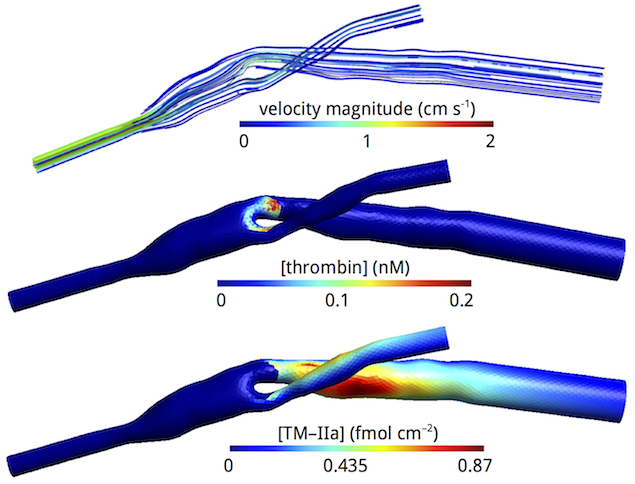Biofluids and Biomaterials
Understanding flow and spatial effects on blood coagulation using computational fluid dynamics
Christian Biscombe, Dalton Harvie, Ineke Muir (CSL) and Steve Dower (CSL)
Christian performed an AMSI Internship in collaboration with CSL on this topic. AMSI Internships are a national Australian initiative designed specifically to partner Industry with relevant research expertise in Australian universities. The Internships run for typically 4 months and are intended to help industry address a specific issue by providing mathematical expertise from the intern and the academic supervisor.
We are now performing a larger Australian Research Council Linkage Project ('Sticky cells: Understanding and modeling platelet flow and binding in blood') in this area, in collaboration with CSL Behring and RMIT University. We are looking for PhD students in this area - see Positions.

Above: The initiation of clotting in response to surface bound tissue-factor (TF) at an occluded femoral artery branch. Mesh courtesy Marchandise et. al., Int. J. Numer. Meth. Biomed. Engng. 2010; 83:876–889
Using Computational Fluid Dynamics to calculate the transport properties of bone and scaffold materials
Christian Daish (RMIT), Romane Blanchard (St. Vincents and Unimelb), Dalton Harvie, Peter Pivonka (QUT)
In collaboration with Christian, Romane and Peter, we have been developing methods to efficiently and accurately calculate macro-scale permeabilities and diffusitivies of porous materials from scan data (eg, microCT scans).
Above: Simulation of the fluid velocity through a periodic section of a bone sample, scanned using microCT and computed using a modified Volume of Fluid technique. The simulations were conducted using the network flow templates available within our open-source arb MFD software.
Publications
| 2012 | |
| [17] | Steady-state oxygen consumption profiles in the cornea (), 2012. |
| 2016 | |
| [16] | Steady-state corneal oxygen consumption profiles during contact lens wear (), 2016. |
| [15] | Trabecular bone anisotropic permeability based on micro-ct imaging and upscaling of porescale fluid flow (), 2016. |
| 2017 | |
| [14] | Mechanical and Fluid Dynamical Characterization of 3d Porous Ceramic Material – Application to Baghdadite Scaffolds for Large Segmental Bone Defects (), 2017. |
| [13] | Mechanisms of flux decline in skim milk ultrafiltration: A review (), In Journal of Membrane Science, volume 523, 2017. |
| [12] | Estimation of anisotropic permeability in trabecular bone based on microCT imaging and pore-scale fluid dynamics simulations (), In Bone Reports, volume 6, 2017. |
| 2018 | |
| [11] | Lift forces on a sphere in bounded and wall-bounded flows (), 2018. |
| [10] | Simulating the behaviour of skim-milk during ultrafiltration Simulating the behaviour of skim-milk during ultrafiltration Simulating the behaviour of skim-milk during ultrafiltration (), PhD thesis, Dept of Chemical Engineering, University of Melbourne, 2018. |
| [9] | Particle Distributions in shear flows: consequences for blood clotting (), 2018. |
| [8] | Lift and Drag forces on a particle near a wall at low Reynolds numbers (), In 21st Australasian Fluid Mechanics Conference, 2018. |
| 2019 | |
| [7] | Numerical calculation of permeability of periodic porous materials: Application to periodic arrays of spheres and 3D scaffold microstructures (), In International Journal for Numerical Methods in Engineering, volume 118, 2019. |
| [6] | Numerical Models of Blood Flow and Thrombosis (), volume Platelet Function & Interactions, 2019. |
| [5] | Simulations of diffusion-mediated factor Xa generation by surface bound tissue factor (), 2019. |
| 2020 | |
| [4] | Modeling Thrombin Generation in Plasma under Diffusion and Flow (), In Biophysical Journal, 2020. |
| [3] | Simulating the ultrafiltration of whey proteins isolate using a mixture model (), In Journal of Membrane Science, volume 613, 2020. |
| [2] | Shear Induced Interactions Cause Polymer Compression (), In Scientific Reports, volume 10, 2020. |
| 2022 | |
| [1] | Flow effects on bradykinin generation in hereditary angioedema (HAE) (), 2022. |